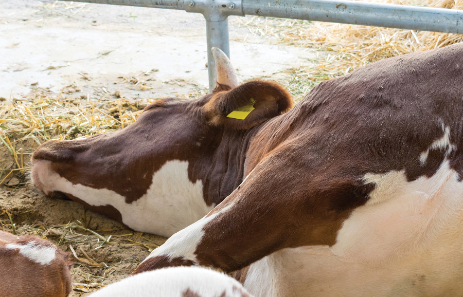Best Practices for Dealing with Downed Cows

By Jaclyn Krymowski.
Handling a sick cow is challenging. Handling a down cow takes the task to another level.
Because this is a situation that can happen quickly and anywhere , even a well-conceived down-cow protocol can make a response challenging. Though each scenario needs to be evaluated at the moment,having a general procedure in advance can help herd managers and farm hands get started.
Understanding the demands of a down cow’s basic needs will ensure she is comfortable and sets her up for potential recovery.
Finally, keep animal welfare in mind and determine when it is necessary to make larger decisions.
Dealing with Downers
There are a few different reasons a cow might go down, such as post-calving difficulties, a metabolic disease (i.e. milk fever) or other illness like mastitis or metritis. Physical injuries due to slippage, hoof issues and blunt force trauma can also cause a cow to go down.
Hypocalcemic animals often fall into the down cow category. Treatment for them is usually therapy including calcium, phosphorus, magnesium, and potassium. But if they do not respond, additional treatment is required.
Regardless of the situation, responders to the incident should first verify why the cow went down. Sometimes it could be a secondary issue that was already present, such as severe dehydration. Assessing the situation can also help determine if a cow needs to be euthanized immediately or if they can be safely relocated and managed.
Make sure the facilities are designed to house a down cow and that there is proper footing in areas where they would be likely to go down.
Handling and Care
Down cows always require immediate attention. All employees should have basic education on proper handling in case they may be called to help move the animal. Typically moving a cow requires three people and avoids disruption of other operations like milking. However, a cow that is truly down should be handled as an emergency situation with all due urgency.
It’s undesirable to try to stabilize a cow on concrete. If she attempts to stand on a slick surface, a fall could put her at an even greater risk for injury. In the event of an emergency, be sure to offer lots of traction by putting down sand, sawdust or another material.
The sick pen or other designated downer area should offer good footing and be dry enough to avoid pathogenic growth. Sand is ideal for preventing high amounts of contaminants, but a bedding of straw could also work.
Provide the cow with clean water at all times, along with some feed. If a cow is not drinking on her own, start a drenching or intravenous schedule.
The designated area or pen for down cows should be identified in advance and included in the plan on hand for employees to reference.
This pen should be out of the elements as wind and rain can reduce body temperature. Straw bedding can provide additional insulation for a down cow.
Cows facing challenges in treatment are those that show no inclination to eat. If a cow salivates over its feed, it is unlikely to consume it later. Rather than presenting large quantities of feed, entice the cow with sweet hay or molasses in concentrates.
A preventative measure is to monitor animals daily. Those that show signs of illness or lameness should be treated immediately to prevent the potential of a down cow.
“It is also necessary to roll the downed animal from side to side at least three times a day, with more frequent movement preferred. If this is not done, the animal’s weight compromises circulation and nerve function to the underside muscles,” writes University of Wisconsin extension educator Sandra Stuttgen in her bulletin Resources for Handling Down Cattle.
The proper way to move down cows – with a sled, loader bucket or lifting devices – should be taught to all relevant employees. Make sure everyone is especially mindful of avoiding sharp equipment edges and the importance of moving slowly. Hip lifts need to be properly secured and never used to drag an immoble animal.
Welfare Concerns
The welfare aspect of downers is crucial to ensure they remain comfortable, and not just managed indefinitely.
There needs to be some level of preparedness to take the big step for animals that are beyond recovery. Likewise, if an animal doesn’t recover after a reasonable period of time, have a plan in place for euthanizing and carcass disposal.
Providing supportive care and pain relief with a drug such as dexamethasone can help keep her comfortable. Be mindful of her pregnancy status as some products can be harmful and cause abortions.
Once she is settled, keep a close eye on her and record observations. It’s important to not allow a cow to linger in limbo. After 24 hours, determine whether she is alert and perky, made progress or is in obvious pain. This can determine the plan of action.
“Daily observations should identify cattle that are unable to stand and there must be a plan in place for how to quickly respond to help these animals,” writes Stuttgen. “The longer cattle are down, the more likely their weight and inactivity will damage circulation and nerve function to their underside muscles, which leads to a poor prognosis for recovery.”
While there may be limited options for addressing a down cow, having a well-defined plan and understanding what signs to observe are imperative.
The significance of close observation extends beyond immediate care. It prevents the worsening of the cow’s condition and avoids unnecessary prolongation of distress. By implementing proper care and handling, one can significantly contribute to minimizing the risk of self-inflicted harm and further damage to the down cow.

